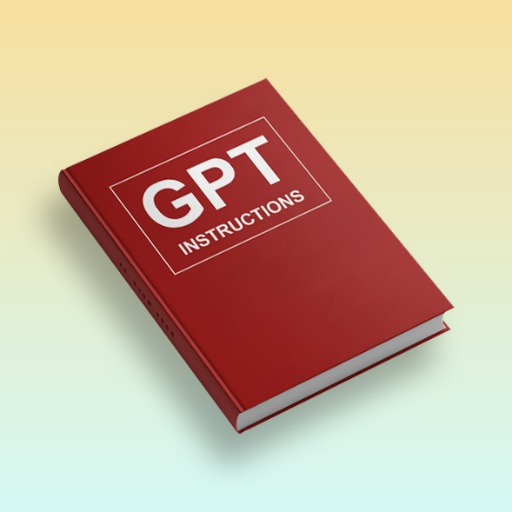Custom GPT-AI-driven tool for diverse tasks.
Custom AI solutions for every need.
Create a GPT that writes fantasy novels.
Build a GPT to tutor high school chemistry.
Develop a GPT for guided meditation sessions.
Create a hyperrealisic 4k image generator that specializes in creating South Park inspired images
Related Tools
Load More
Create a GPT
Assists in GPT model creation

GPT Builder Builder
Your guide to creative GPT building.

Inception GPT | Custom GPT Maker | Custom GPT
I create prompts so you can build your own custom GPT AI chat tool with advanced machine learning and self improving models. Your Custom GPT Maker is the ultimate inception tool to make your own custom GPT for any AI powered business. Your Chat GPT AI gam

Instruction Creator
Custom GPT instruction creation guide. Copyright (C) 2024, Sourceduty - All Rights Reserved.

GPT Action Creator
This GPT helps create Action Schemas which other GPTs can use.

Better GPT Builder
Guides users in creating GPTs with a structured approach. Experimental! See https://github.com/allisonmorrell/gptbuilder for background, full prompts and files, and to submit ideas and issues.
20.0 / 5 (200 votes)
Introduction to Custom GPT
Custom GPT is a highly adaptive AI system designed to meet the specific needs and requests of users, capable of transforming into any type of assistant or service the user envisions. It operates with flexibility, handling a wide array of tasks from creative problem solving to data analysis, technical research, and personalized content generation. Custom GPT combines advanced natural language processing with live web search capabilities, ensuring that responses are up-to-date, relevant, and deeply informative. A key feature is its ability to create personalized outputs that align with user needs, whether that involves complex analytical reports, custom writing, or creative projects. For example, a user might ask Custom GPT to serve as a technical assistant for a research project, where it would gather relevant data, analyze findings, and generate detailed reports based on the user's requirements. Another scenario could involve the AI acting as a creative consultant for content creators, helping generate ideas, structure outlines, and write full pieces tailored to the user's style.

Main Functions of Custom GPT
Data Analysis and Visualization
Example
A business executive requests an analysis of global market trends in renewable energy. Custom GPT uses its web search capabilities to gather real-time data, then provides insights through charts and diagrams to help the executive understand potential investment opportunities.
Scenario
A user needs an in-depth report on the potential impact of climate change on specific industries. Custom GPT collects and analyzes current scientific data, interprets key trends, and delivers a concise, easy-to-understand report, complete with graphical visualizations.
Creative Content Generation
Example
An author asks Custom GPT for assistance in developing a plot for a novel. The AI suggests multiple creative pathways based on the author’s initial concept, then helps flesh out characters, settings, and chapter structures.
Scenario
A content creator needs blog posts tailored to a niche audience. Custom GPT not only generates ideas but also writes complete, SEO-optimized articles ready for publication, ensuring the tone and style match the creator's voice.
Technical Support and Coding Assistance
Example
A software developer uses Custom GPT to debug code, offering suggestions to optimize functionality and ensure compatibility with various platforms.
Scenario
A user working on a machine learning model needs help refining their algorithm. Custom GPT reviews the code, identifies potential improvements, and offers suggestions for increasing model accuracy while explaining each step clearly.
Ideal Users of Custom GPT
Researchers and Analysts
This group benefits from Custom GPT’s ability to gather, analyze, and synthesize large volumes of information quickly. Whether conducting scientific research, market analysis, or policy evaluations, Custom GPT provides in-depth insights, thorough reports, and accurate data visualizations. Its capability to access real-time data via web search ensures that findings are current and relevant.
Content Creators and Writers
Writers, bloggers, marketers, and creative professionals gain immense value from Custom GPT’s content generation capabilities. Whether they need assistance in brainstorming ideas, writing full-length articles, or refining existing drafts, Custom GPT helps streamline the creative process, ensuring consistency in tone, style, and quality. Its ability to cater to specific audiences or niches makes it an invaluable tool for those in content creation.

How to Use Custom GPT
Step 1
Visit aichatonline.org for a free trial without login, no ChatGPT Plus required.
Step 2
Decide what specific role or task you want the Custom GPT to perform. Identify your use case, whether it's content generation, research, data analysis, or other functionalities.
Step 3
Use the platform's customization interface to define the specific instructions and capabilities needed. Tailor the AI to your preferences, adding specific instructions about the role, tasks, and interaction style.
Step 4
Test your custom setup by asking detailed, task-specific questions or providing complex prompts. Evaluate its responses and make further adjustments to improve accuracy and relevance.
Step 5
Leverage advanced features like live web research, data visualization, or task automation to optimize your output. Use iterative refinements to align the GPT with your evolving needs.
Try other advanced and practical GPTs
Girlfriend Luna
Your AI-powered virtual companion.

Blood Test Result Analysis for Health Insight
AI-Powered Blood Test Analysis for Better Health

Art Scholar AI
AI-powered insights for art scholars.

Fantasy Map Creator
Bring your fantasy world to life with AI.

Buddy
AI-powered assistance for all your needs.

AgelessGPT
AI-driven insights into aging and longevity.

FPGA/ASIC Engineer
AI-powered FPGA and ASIC design tool

Human Design Explorer
AI-powered personalized Human Design tool

FlowChartGPT
Visualize complex processes with AI.

Market Insight - Crypto Chart Technical Analysis
AI-powered technical analysis for crypto charts

Shield Challenge - v2
AI-Powered Puzzle Challenge for Critical Minds

Kato, Keeper of Secrets
AI-powered secrets, language games, and more.

- Content Creation
- Data Analysis
- Research Assistance
- Coding Help
- Business Planning
Frequently Asked Questions About Custom GPT
What is Custom GPT and how is it different from regular GPT?
Custom GPT is a version of AI that allows users to define its role, behavior, and functionalities based on their needs. Unlike standard GPT, it is tailored to specific tasks such as research, technical writing, or creative assistance, offering greater control and precision.
What are the most common use cases for Custom GPT?
Common use cases include academic research, content creation, data analysis, business planning, and coding assistance. The tool can adapt to almost any professional or personal project requiring detailed information or automated workflows.
What are the key prerequisites to use Custom GPT effectively?
The main prerequisite is a clear understanding of what task you want the GPT to accomplish. You should also be familiar with structuring instructions to guide the AI in producing accurate and relevant results.
Can Custom GPT perform tasks involving real-time data or live web searches?
Yes, Custom GPT has the ability to conduct live web searches and provide data-driven insights, making it ideal for tasks requiring real-time information, such as market research or event tracking.
How customizable is the interface and user interaction with Custom GPT?
The customization is extensive. You can define not only the task but also how the GPT communicates, what type of data it focuses on, and the style of responses it provides. It's flexible enough to evolve with the user's requirements.